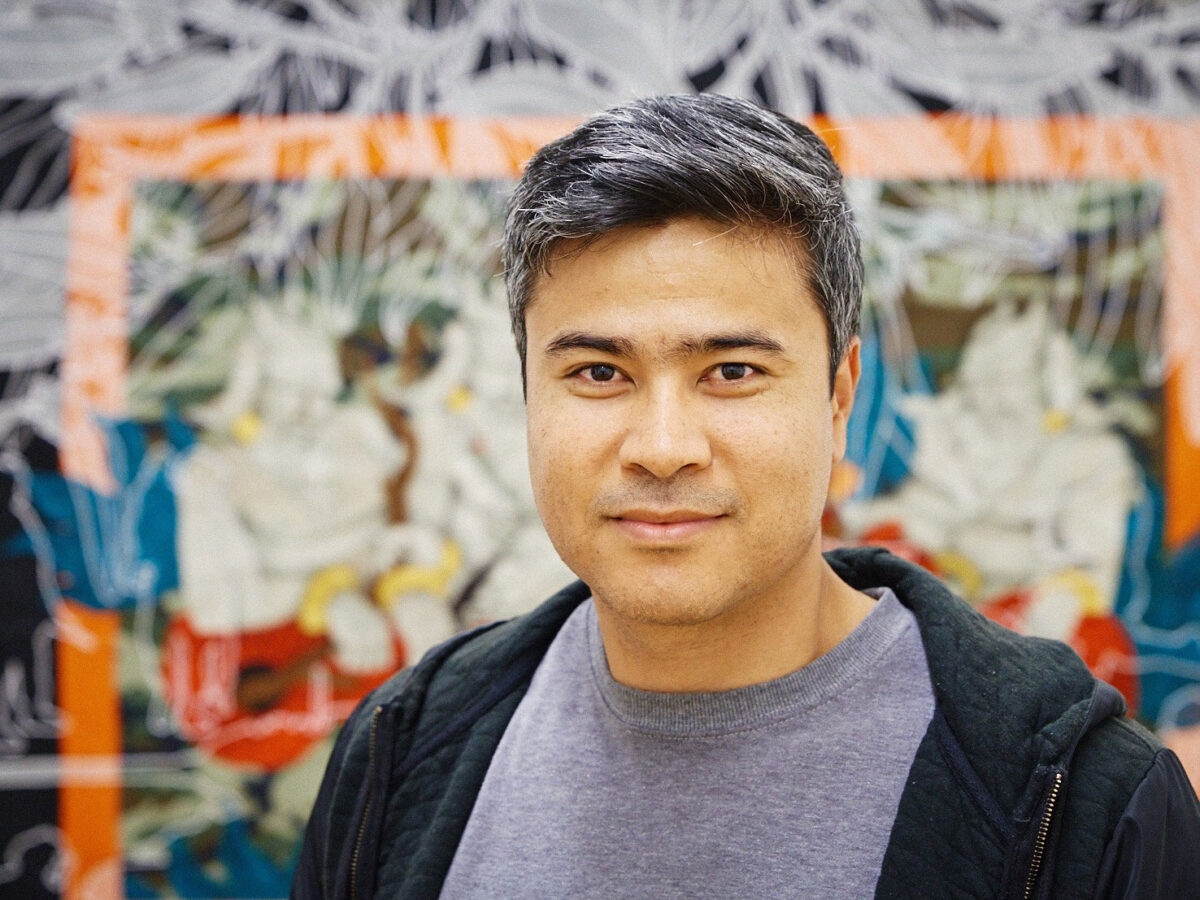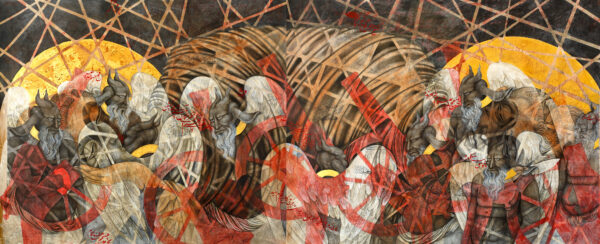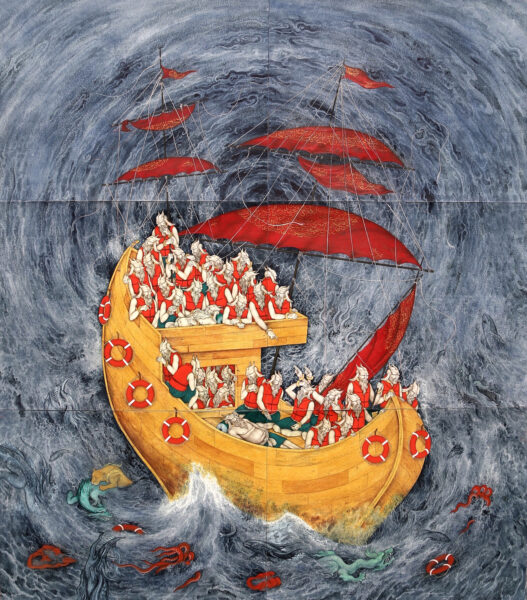
Demons of otherness: A conversation with Khadim Ali
By Safdar Ahmed
Khadim Ali and I meet in Ashfield’s Thirning Villa artist residency, a sedate, peach coloured, colonial era building in the Georgian style. Located between a modern day bowling club and picturesque tennis courts, it has been an artist residency for many years and is now the unlikely home of Refugee Art Project, a nonprofit community art organisation that facilitates art workshops for people of an asylum seeker or refugee background. I have been volunteering with that group for over a decade, and have known Ali since 2011, when he accompanied me and some friends on a visit to the Villawood detention centre.
I’ve long admired his work but this is my first opportunity to pick his brains about it. His paintings are delicately layered compositions, mixing voluptuous figuration with exquisite calligraphy and flat decorative elements. The imagery is imbued with a strong sense of narrative, symbolism and mythology.

Medium: gouache,ink and gold leaf on paper.
320x140cm
Our conversation opens with the Shahnama, or ‘Book of Kings’, an epic poem of up to 50,000 rhyming couplets which stems back to the ancient oral-poetic traditions of Central Asia and Iran. Penned by Hakim Abul-Qasim Ferdowsi in the royal court of Ghazni in the year 1010 c.e., it records fantastic tales of ancient monarchs, romance, legendary knights and mythical demons.
A key motif in Ali’s work is the dev, or demon, which is used to reflect critically on the experience of marginalisation. He describes how the Hazara people, including his own family, have been historically ‘othered’ in such places as Afghanistan, Iran and Pakistan. The demon in this context is a means of grappling with the very process of dehumanisation, how it takes place and under what circumstances.
‘This mistreatment. These differences. These distances. This otherness. These are the things that I was looking into and it was referring me to the stories of my childhood from the Shahnama.’
If there’s a thematic line from the poem to Ali’s art, it traces the fertility of language and the imagination across cultures and geographies. The Shahnama is not simply an important text in modern Iran (where intellectuals funneled it to service a celebratory type of cultural nationalism) but constitutes a wellspring for many Turkic speaking peoples, Georgians, Afghans, north-Indians, and others who came under the influence of Persian literary culture in the premodern Muslim world.
Ali latches onto specific images and themes from the poem, which he uses to narrativise a long history of dispossession, and which ultimately lands here, in our own time and place.
***
Born in Quetta, Pakistan, Ali belongs to the Hazara ethnic minority of the Shia’ religious confession, who have been persecuted in Afghanistan since the late 19th century. His ancestors fled their traditional home in Ghazni where they worked as patrons to the royal courts. His paternal grandparents sang the Shahnama amongst other literary masterpieces, a tradition they brought with them as refugees to British-controlled India and what in 1947 became Pakistan.
Ali recalls sitting next to his grandfather as a young boy, surrounded by his family and other Afghan refugees, listening
enraptured, as the old master recited melodious poetry. His grandfather would open a printed edition of the Shahnama and point to its paintings, identifying various characters and scenarios. In his late teens and early twenties, Ali studied mural painting and calligraphy in Tehran, before returning to Pakistan, where he enrolled at Lahore’s College of the Arts to learn miniature painting. This felt to him like a return to the creative tradition of his family line. A return to the mythopoetic realm.
In Lahore Ali was trained under the modern miniaturist Imran Qureshi in the Indian Mughal school, which has strong historical connections to the painting styles of Iran and Central Asia. At this point our conversation turns to Behzad (1455-1535), an artist of the late Timurid era whose innovative compositions and formal sophistication has influenced miniature painting for centuries.
‘In his own time he was in search of different styles… he started painting his surroundings, the bazaars, the construction, the laymen, the city-scape.’
The desire to adapt old forms for contemporary needs no doubt informs Ali’s own approach to traditional visual and literary idioms. Just as Mughal painters took their art beyond the manuscript to create large scale mural paintings and embroidered tapestries, so Ali adopts a wide range of techniques, from painting in gouache and watercolour to mural painting, large woven carpets and steel cut images.
***
‘The exilic intellectual does not respond to the logic of the conventional but to the audacity of daring, and to representing change, to moving on, to not standing still.’ Edward Said

Medium: gouache and gold leaf on paper.
140x156cm
Ali finds strong parallels between the demons of the Shahnama and the condition of political abjection enforced on Hazara communities in modern times.
‘The demon would live in a cave, and so Hazara’s resorted to living in caves in the area of Bamyan. Just as Hazaras are referred to in polemical texts as ugly creatures, as rebellious people who eat rats and insects, so were the demons in the Shahnama… So I started painting the demon as a collective portrait of my ancestors and my own self.’
In this context the Shahnama’s visual and symbolic language is not mined to reclaim a sense of identity and heritage. It is not about defining cultural goods in the construction of a collective or national identity. The demon is a fulcrum of historical experience. It reflects the anxiety, trauma and displacement of Hazara Afghans in the modern world. But it also clears a space for creative action, recuperation and critique.
***
Ali’s art holds a torch to the cliche of the grateful refugee or model migrant, though on the surface his story might resemble just that. His art was recognised in Pakistan, which enabled him to travel to Australia on a Distinguished Talent Visa. Once here he studied a Masters in Fine Arts at UNSW School of Art and Design. He has exhibited locally and internationally and now has studios in Sydney and Kabul.
Yet his chosen themes do not fit within the officially sanctioned narrative of migration, which ends in his winning the ‘lottery’ (to cite Tony Abbott) of Australian citizenship.
‘I looked into the life of refugees and how they are put into detention centres. The government calls them “illegal arrivals”. So this story of demonisation and otherness is an ongoing thing.’
The same can be said for how the media and institutions tasked to support refugees approach the issue.
‘When the media or institutional organisations work for refugees, it’s not that they are working with passion to do something… it’s more project-based.’
This is not to say there are no well-meaning individuals within the system, but the colonial state is not structured in such a way as to foster a culture in which people feel genuinely welcomed. I take this to mean Australia has not prepared the ground for affective experiences of inclusion and belonging.
‘If they have funding they will work for the refugees. If they don’t have funding they won’t care about you. They wouldn’t know you the next day.’
The same goes for the cultural sector, where institutional whiteness has not adequately serviced Australia’s diverse communities.
‘The museums are bringing exhibitions from different cultures and backgrounds now and then but there is less talk about it… The media should talk about [cultural diversity] more because we are the future of Australia.’
Because mainstream Australia knows Afghanistan only through the reductive prism of the ‘war on terror’, there is little if any positive conception of the country in our popular consciousness, and no awareness of its rich cultural and artistic history.
***
We end our conversation dwelling not so much on the role of storytelling and the mythopoetic frame, but where it cracks under the pressure of history, and how its various pieces can be re-assembled.
Ali speculates about a museum of displaced people, observing ‘Australian culture is a displaced culture’. To properly acknowledge Australian history and the role of Aboriginal people as the sovereign owners and custodians of this country is to come to terms with our own place as settlers.
He describes the thrill of discovering traditional and contemporary Aboriginal art, and how that contributes to a sense of belonging in a country he can respectfully understand.
Indeed if there’s one theme I draw from our conversation it is Ali’s insistence on culture and tradition as things to study, value, protect and extend. This accompanies a critical vigilance towards the ways people are mischaracterised and demeaned within mainstream political discourses.
The demon’s role in this context is manifold. It is both a figure of rejection and means of empathy. Through its abjection, we may yet find a way to engage and make peace with the other.

Medium: gouache,ink and gold leaf on Wasli paper.
Dimension: 220x75cm
This interview with Khadim Ali was conducted, and this profile written, on the unceded lands of the Gadigal and Wangal peoples of the Eora Nation.
First published in Sydney Review of Books on 22 November, 2021. Article commissioned by Diversity Arts Australia for the Pacesetters Creative Archives project, which was funded through Create NSW.
